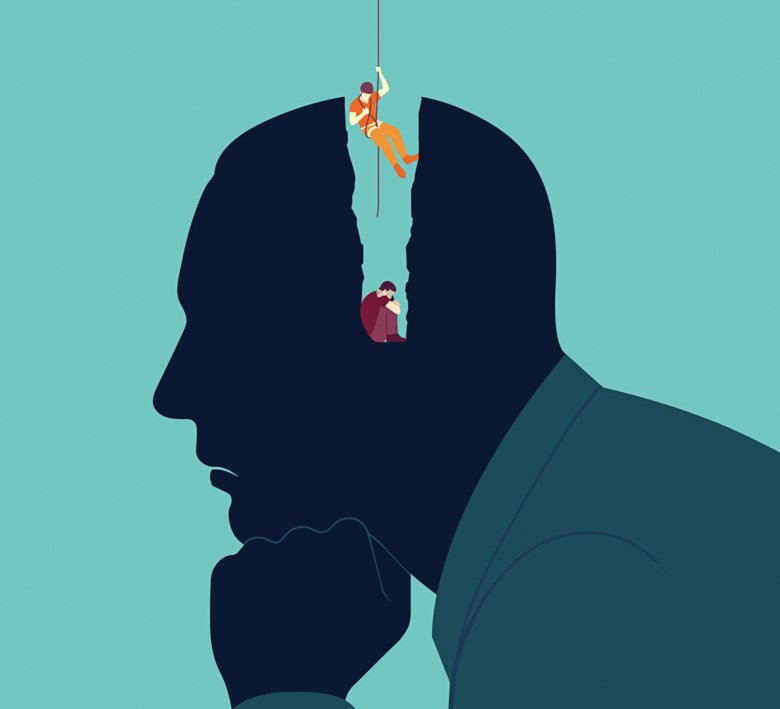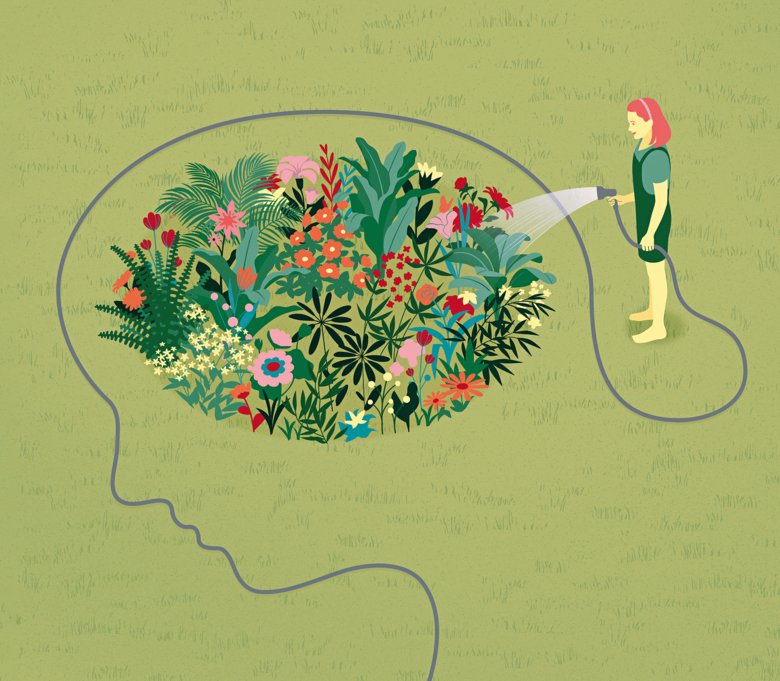Hold on and hold out – save more people from suicide
Approximately 1,500 Swedes commit suicide each year. Although major efforts are being made to save more of those who see death as the only way out, much remains to be done.

Text: Annika Lund, first published in Swedish in the magazine Medicinsk Vetenskap No 3/2020 / Spotlight on suicide prevention
In 2019, there were 1,269 confirmed suicides in Sweden. A further 319 people died in suspected suicides. This means that every day, over four people in Sweden take their own lives out of sheer despair. Even more people try unsuccessfully. During 2018, 6,600 people were hospitalised for serious self-harm. Thousands more suicide attempts take place without healthcare becoming involved: even more live with suicidal thoughts.
Suicides had been on the decline in Sweden until the early 2000s, but since then the number of suicides per 100,000 inhabitants has remained relatively stable. In the lower age group of 15-24, over the past decade suicides have even risen, with an annual increase of approximately 1%. This also applies to women between the ages of 25 and 44.
Although in the very lowest age group, children under the age of 15, the total is very low, even here suicides do occur: in 2019, six children under 15 years of age took their own lives.
Reduce the risk
“We can’t say that the measures we have taken have been ineffective – after all, we don’t know what the suicide rate might have been without them, perhaps even higher – but we still need to understand why we have failed to reduce the number of suicides. More research is needed to understand why,” says Vladimir Carli, a researcher at the National Centre for Suicide Research and Prevention (NASP) at Karolinska Institutet.
He explains that suicide researchers normally divide measures into those that reduce the risk of and those that increase protection against suicide. Measures can be further divided into societal, local, family and individual levels; for example, at a societal level, bridge railings are seen as a risk reduction measure, while access to healthcare increases protection. At a more local level, in schools for example, the risk of suicide can be reduced by measures to prevent bullying and protection can be increased by improving students’ sleep, perhaps by beginning the school morning later. That said, not all risk and protection measures are achievable through political decisions or social initiatives; for example, religious belief may offer protection, likewise a strong social network.

Vladimir Carli has participated in a major international study led by the NASP at Karolinska Institutet in which various methods to promote mental health and prevent suicide among school children were compared. The study included 11,110 students from 168 schools in 10 European countries.
The schools were randomly allocated to one of four groups. In the first group, healthcare professionals met all of the students and screened for mental health, offering treatment to those who required it. In the second group, teachers were trained to recognise mental illness and encourage students to seek help. The third group of schools was a control group in which students received minimal intervention.
In the final group, measures were targeted at the students themselves. They participated in five training sessions in which they had the opportunity to discuss various aspects of mental health such as stress, crises, depression and suicidal impulses. They were also taught the benefits to mental wellbeing of healthy habits related to sleep, physical exercise and diet. They were informed of how to help a friend who is going through difficulties and how to seek help themselves. All information was summarised on posters and displayed on classroom walls for four weeks and distributed to students in a booklet.
Best effect on suicidal behaviour
This package had by far the best effect on suicidal behaviour, with suicide attempts 50% lower among students who had been given the opportunity to train themselves to deal with mental ill health than in the control group. No suicide was recorded in any of the groups.
This educational package, Youth Aware of Mental Health (YAM), is currently being implemented in Swedish schools, partly in the form of an ongoing study, as Vladimir Carli explains.
“The measure is not specifically aimed at suicide but rather mental illness in general. The aim is to strengthen the protection factors around the youths. The measure stimulates discussion about diet, physical activity and sleep and emphasises the importance of seeking help when needed,” he says.
It is already well-established that certain mental illnesses, such as depression and bipolar disorder, increase the risk of suicidal behaviour. There is also a great deal of research confirming that treating these disorders reduces the risk of suicide. There are however few therapies specifically designed to treat suicidal behaviour.
Ullakarin Nyberg, a researcher at the Centre for Psychiatry Research at Karolinska Institutet, is planning for just such a study, in which individuals deemed to be highly suicidal will receive treatment specifically targeted at their suicidal behaviour.The study is planned to include individuals who have ended up in accident and emergency units after surviving a suicide attempt. They will be offered a form of psychotherapy called acceptance and commitment therapy (ACT) as a supplement to the treatment they are already receiving under current procedures. ACT is sometimes referred to as third-generation cognitive behavioural therapy (CBT).
How to live a meaningful
In brief, this therapy involves encouraging the patient to identify those aspects of their life that they feel are important and to then try to devote themselves to these as much as possible, within the framework of what is achievable in their own live. In the variant of ACT to be offered in the study, there will be a particular emphasis on how to live a meaningful life in the face of feelings of hopelessness and resignation.

“Today, there is a great deal of focus on eliminating difficult feelings. When someone seeks medical care there is sometimes an expectation that this is what will happen, both on the part of the patient and the caregiver; however, much of the suffering people struggle with is beyond influence. One reasonable goal is to learn to live with and relate to difficulties of various kinds – to have stratagems prepared to help you hold out. One very good question to ask someone with suicidal tendencies is: what has helped you to survive up to this point? Most people can answer that. It might be their children or jogging or a general respect for life. We can then help the patient to reinforce whatever it is that has held them back from suicide. This may be a matter of taking out a photograph of the children whenever suffering becomes too much, to remind themselves who they will be hurting if they kill themselves,” says Ullakarin Nyberg.
The study is still being designed but ACT is one of the treatments that will be evaluated. Another is something called brief intervention, maintaining contact with a suicidal patient by telephone or postcard after they have been discharged, asking how they are feeling and encouraging them to seek medical care should the need arise. Physical activity will also be included in the treatment and researchers from the Swedish School of Sport and Health Sciences (GIH) will be taking part in the project. A large amount of data will also be gathered from study subjects; for example, through the collection of blood samples and questionnaires to measure mental health.
Ullakarin Nyberg has a vision of a society in which the public is well-educated regarding the processes happening in someone who sets out to plan a suicide. She draws parallels to cardiology, which has succeeded in conveying a strong awareness of the fact that chest pains radiating down the left arm signal an immediate need to seek medical attention.
“We would get a long way if people were equally clear that they should seek help in the event of strong feelings of hopelessness and resignation. And, if suicidal impulses are on the verge of being translated in action, one should immediately seek to protect oneself by sounding the alarm,” she says.
The final, decisive step in a suicide is often taken on impulse. If this could be averted, the vast majority would go on living. As many as 90% of those who survive a suicide attempt live to die from other causes.
Difficult to grasp
That said, it is difficult to grasp that someone might be about to take their own life. Ullakarin Nyberg has watched dozens of suicides on CCTV where people throw themselves in front of trains and their behaviour on the platform rarely offers any clues. Some stand there quite inconspicuously, perhaps holding their phone or rooting through their handbag, completely calm. Then, suddenly, as the train approaches at speed, they take one stride forward onto the track.
“Suicidal intentions are not visible externally. If we are going to succeed in reducing the suicide rate, we need the help of the individuals in question, those who are at risk of ending up in a situation where death seems to be the only way out. We need to regard them as experts on their own lives and find a way to collaborate, with the common goal of preventing suicidal impulses from being put into action. It’s not what you think that kills you – it’s what you do. And it is possible to get help,” says Ullakarin Nyberg.

She draws another parallel to heart medicine, imagining an app similar to the existing SMS Lifesavers, which allows volunteers proficient in CPR to sign up and receive an alert if they are in the vicinity of a person suffering sudden cardiac arrest, given that someone has called the emergency number. The volunteer can then run to the scene and perform CPR while waiting for the ambulance to arrive.
“One can conceive of something similar for people with suicidal tendencies: an app that alerts volunteers to run to the scene to avert a death, but by suicide rather than cardiac arrest. Someone with suicidal impulses could download the app and activate the alarm if the thoughts become so intrusive that they risk tipping over into action,” says Ullakarin Nyberg.
Bipolar disorder and schizophrenia
As previously noted, it is well-established that certain mental illnesses such as bipolar disorder and schizophrenia increase the risk or suicide; however, far from everyone with a mental illness commits suicide. One in ten Swedes – that is one million people – take antidepressants. Very few of these take their own lives. Depression in and of itself does not explain suicide. Many more components come into play, one of which may be congenital conditions. Together with the head of the centre Professor Danuta Wasserman, NASP researcher Marcus Sokolowski has spent many years unravelling the genetic factors behind suicide. Among other things, they have studied the DNA of 660 groups each consisting of a suicide victim, either completed or who has made a serious attempt, and their biological mother and father in a process known as trio sequencing.
Marcus Sokolowski and Danuta Wasserman have attacked this issue from several directions. Firstly, they looked for the presence of specific genes that other studies had shown to be significant to suicide, such as those linked to stress and serotonin uptake.
These studies offered some clues in as much as some of these gene variants were more common in the sequenced trios than in the population at large, something that led to several interesting conclusions; for example, it was possible to see complex connections between suicide and variants of the gene CRHR1, a known determinant of stress. The researchers were able to see patterns linking one specific variant of this gene to suicidal behaviour and women who had been sexually abused at a young age. There was also a connection between another variant of the gene, suicidal behaviour and men who had been subjected to physical violence later in life. A third variant of the gene was found in both women and men who had been subjected to sever stress at various times in life.

“What we saw suggested a genetic variation in how we are affected by trauma. To be genetically susceptible and then be subjected to a trauma appears to pave the way for suicidal behaviour later in life if the individual is subjected to further stress,” says Marcus Sokolowski.
These trios have now been studied using whole genome sequencing, an unbiased approach for the identification of genetic variations in an individual. This too provided results, showing that some gene variants are more common in individuals with suicidal tendencies; however, no gene variant was frequent enough to be described as crucial to suicidal behaviour. In both cases – the search for specific genes and the sequencing of the whole genome – the results obtained by different research groups have differed markedly.
This is one of the nightmares of the scientific community: results that cannot be repeated. Are they simply wrong?
The genetic component
The research community does not believe so, as Marcus Sokolowski explains. While researchers have dropped the idea of identifying one or a few ‘suicide genes’ that greatly increase the risk of taking one’s own life, they still describe the genetic component of suicide as relatively strong. Twin studies, as well as other studies that can weight genetic and environmental contributions, rate the hereditary component of suicide at anywhere between 30 and 55%.
“Our current belief is that, for the vast majority of people, the presence of many different gene variants is required at the same time to increase vulnerability to suicidal behaviour. So, we think that many and varied genes are involved simultaneously and which these are can vary from case to case. This would explain why different research groups have obtained different results. The study subjects have presumably had different combinations of a vast number of gene variants, all of which may lay the foundations for vulnerability to suicide. Genetics will never be able to explain everything about suicide; you also need to include environmental factors, such as trauma, stressful life events and access to the means to commit suicide,” says Marcus Sokolowski.

In further studies, he and Danuta Wasserman have reviewed many gene variants that have stuck out in whole genome sequencing performed by their own and other research groups, combining this with other already known biological “evidence” for each gene. It was possible to link some 3,900 genes to suicidal behaviour or various mental illnesses. They then discarded those that could only be linked to mental illnesses. This left just over 40 genes that appear to play a specific role in suicidal behaviour, given that they are not associated with illnesses such as depression or bipolar disorder. Their detective work thereby pointed to the 40 genes with the greatest significance – i.e., the strongest scientific support for association with suicidal behaviour – although these genes may in turn interact with others of relevance to various mental illnesses.
It became apparent that the 40 genes in question all play a role in something as fundamental as the brain’s development – the ability to create new neurons in the womb and to repair damage later in life. They were also involved in neuroplasticity, the brain’s ability to change and adapt to experience, and in physical stress reactions.
“It is extremely difficult to interpret this finding. You have to bear in mind that the brain’s structure affects its function. Purely hypothetically, I can imagine that impaired flexibility in the brain may impair the individual’s ability to adapt, something that in an extreme situation leaves them prone to become locked on a thought, unable to find a constructive solution,” says Marcus Sokolowski.
May be the trigger
The road to suicide may therefore look something like this: it begins with a genetic predisposition to commit suicide, a vulnerability that can be exacerbated by trauma and may lead to poorer handling of difficult events later in life; subsequently, if someone suffers mental illness or goes through a crisis, perhaps caused by death of a loved one, unemployment or the diagnosis of severe illness, this may be the trigger that turns suicidal impulses into concrete plans. If this happens and the individual has available means, such as a large quantity of drugs or a bridge from which to jump, then the result may be suicide, especially when under the influence of alcohol.
Considerably more men take this path than women, accounting for two thirds of all suicides. This pattern seems to recur everywhere: in all age groups, socioeconomic groups and in all countries. One region of China has been highlighted as an exception, although the figures have been called into question. Gergö Hadlaczky, another researcher at the NSAP at Karolinska Institutet, describes a number of reasons behind the overrepresentation of men; for example, that they generally have weaker social networks, drink more alcohol and are less inclined to seek help when they feel overwhelmed, all of which increases the risk of suicidal behaviour.

Depression is also a risk factor, as is any previous attempt to commit suicide; however, both of these factors are more common among women.
“The question of why more men than women commit suicide is a very complex issue, more complex than one might think,” says Gergö Hadlaczky, whose research interests include decision-making related to suicide, a field with its roots in behavioural economics. One important name in this field is Nobel Laureate Daniel Kahneman, who was awarded the prize for economics in 2002 for his theories.
One concept in behavioural economics is loss aversion, which deals with our tendency to prefer avoiding losses to acquiring equivalent gains. This can be investigated scientifically; for example, by circulating a questionnaire. One question might be something like: “We are going to toss a coin. Heads, you win €50. Tails, you lose €45. Do you want to play?
Even though the wager is actually in the player’s favour, given that a yes will eventually yield a profit, the vast majority answer no; however, if you change the amounts to make them even more profitable to the player, they will eventually accept the wager. This allows us to obtain a ratio between the desire to win and the unwillingness to lose: a ratio of the individual’s willingness to act. For most people, the ratio looks something like this: when the possible profit is double the possible loss – when a €50 profit stands against a €25 loss – then we choose to act. This result has been repeated countless times among groups from various backgrounds and different cultures.
This element of behavioural economics has now found its way into suicide research and Gergö Hadlaczky is one of those studying it. Together with colleagues, he has studied loss aversion among 2,100 school students from seven European countries, including Sweden.
Pronounced aversion to loss
The expected pattern was repeated. A majority of students had a pronounced aversion to loss and sought to protect themselves from it. It was not until the possible win/lose ratio was adjusted to €6/€3 that they agreed to play. A smaller percentage of students did not reason in the same way; they accepted the wager even when the risked loss was almost equivalent to the possible profit – they had a lower aversion to loss. This behaviour was significantly more common among boys than girls, something that also follows the expected pattern given that men in general are known to have a lower aversion to loss than women.
After four months, a number of follow-up questionnaires were sent to the students, at which time 75 individuals stated that they had attempted suicide during the intervening period. The figure was significantly higher among those who had demonstrated a lower loss aversion at the start of the study. The increased risk of a suicide attempt was clearly linked to loss aversion in both sexes; however, this behaviour was and remains more common among males, both in this study and generally.
According to Gergö Hadlaczky, a number of studies have yielded similar results. Those with suicidal tendencies appear to exhibit deviant decision-making behaviour compared to the wider population: they seem less inclined to avoid losses.
“We know that those planning to take their own lives experience a great deal of anguish. In such a situation, the profit is to avoid that anguish. The loss, aside from one’s own life, is the grief and loss inflicted on loved ones; however, someone with lower loss aversion is less focused on the losses. Such a person is focused on the profit; i.e., the avoidance of suffering,” says Gergö Hadlaczky.
Is it possible to influence loss aversion?
“Yes, it is. There are studies suggesting that it may be sufficient to raise awareness of the phenomenon, thus causing the person to change focus to look at potential losses; however, these studies have been conducted on people working in the finance sector rather than suicidal individuals.”
Do you need someone who listens?
Mind suicide hotline: Tel +46(0)8 90101 and chat room at all hours
Children's hotline BRIS: Tel +46(0)8 116111, all days 14 to 21 hrs.
In an emergency: Call 112 (in Sweden)
More reading
 Photo: Martin Stenmark
Photo: Martin StenmarkThe reawakening of depression research
The antidepressant ketamine has lead to a reawakening within the field. This according to Johan Lundberg who sees new possibilities to find a cure for one of the world’s most widespread disorders.
